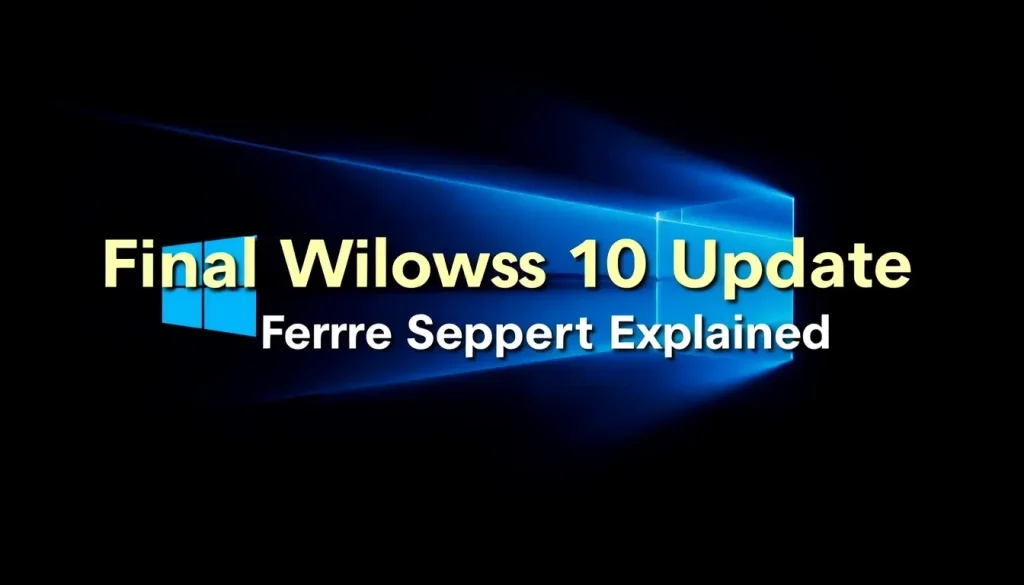Final Windows 10 Update Before Support Ends Details Explained

As the tech landscape rapidly evolves, Microsoft is making significant changes to its operating systems. With the end of support for Windows 10 approaching, users need to be well-informed about what this means for their systems. This article explores crucial details about Windows 10's support lifecycle, the implications of its end, and what users can do to secure their devices moving forward.
Windows 10 end of support timeline and implications
The official end of support for Windows 10 is set for October 14, 2025. This marks a significant milestone for users who rely on this operating system, as it signals the cessation of all regular updates, including security patches. The final update, identified as update KB5066198, was recently released and is optional to install. However, it provides essential fixes rather than new features, addressing specific connectivity issues that could disrupt user experience.
What happens when Windows 10 support ends?
When support for Windows 10 ends, users will no longer receive critical updates. This cessation can lead to several potential risks:
- Security Vulnerabilities: Without security patches, systems become susceptible to malware and cyberattacks.
- Software Incompatibility: New applications and updates may not work on outdated systems.
- Technical Support: Microsoft will cease providing customer support for Windows 10, leaving users to troubleshoot issues on their own.
These factors can significantly impact personal and professional environments, making it imperative for users to consider their options as the deadline approaches.
Windows 10 extended support options
For those who are unable to upgrade immediately, Microsoft offers an Extended Security Updates (ESU) program. This program is designed for organizations needing additional time to transition from Windows 10. However, it's essential to note:
- The ESU program is opt-in and incurs additional costs.
- Only security updates will be provided under this program, not new features or enhancements.
- Users must stay current on their ESU subscriptions to continue receiving updates.
Organizations that choose this path must weigh the benefits against the costs and potential risks of continuing to operate on an unsupported platform.
The future of Windows 11
As Windows 10 support nears its end, many users are contemplating a transition to Windows 11. This newer operating system offers enhanced features, performance improvements, and a more modern interface. However, users should be aware of:
- System Requirements: Windows 11 has more stringent hardware requirements compared to Windows 10.
- Learning Curve: Users may need time to adapt to the new interface and features.
- Future Updates: Windows 11 will continue to receive regular updates and support beyond the 2025 deadline for Windows 10.
For those considering an upgrade, evaluating hardware compatibility and training needs is crucial for a smooth transition.
Can I still use Windows 10 after 2025?
Yes, users can technically continue to use Windows 10 after support ends, but this comes with significant caveats:
- Increased Risk: Operating without updates exposes systems to security threats.
- Lack of Support: Users will not have access to official support channels for troubleshooting.
- Software Limitations: Over time, software developers may stop supporting Windows 10, rendering popular applications unusable.
While it is possible to use Windows 10 post-2025, it is not advisable for users concerned about security and functionality.
Understanding the Extended Security Updates (ESU) program
The ESU program provides a critical lifeline for businesses and organizations that rely heavily on Windows 10. It enables them to continue receiving vital security updates after the official end of support. Here are key details about the program:
- Eligibility: Primarily aimed at enterprise customers, this program is optional and comes at a cost.
- Coverage: The program will provide updates for three years following the end of support.
- Subscription Tiers: Organizations can choose from various levels of subscription based on their security needs.
Organizations must carefully evaluate their security strategies and consider the long-term implications of remaining on Windows 10.
Why is Windows 10 support ending?
Several factors contribute to the decision to end support for Windows 10:
- Technological Advancements: As technology evolves, maintaining outdated systems becomes increasingly challenging.
- Focus on Newer Versions: Microsoft aims to promote Windows 11, encouraging users to adopt newer technologies.
- Resource Allocation: Streamlining support efforts allows Microsoft to allocate resources more effectively towards current and future systems.
Understanding the rationale behind this decision can help users make informed choices regarding their operating system needs.
Conclusion
As Microsoft prepares to transition away from Windows 10, users must proactively consider their options. Whether it's leveraging the ESU program, upgrading to Windows 11, or continuing to use Windows 10 at their own risk, staying informed is essential. For further guidance on preparing for the end of Windows 10 support, consider watching this informative video:




Leave a Reply